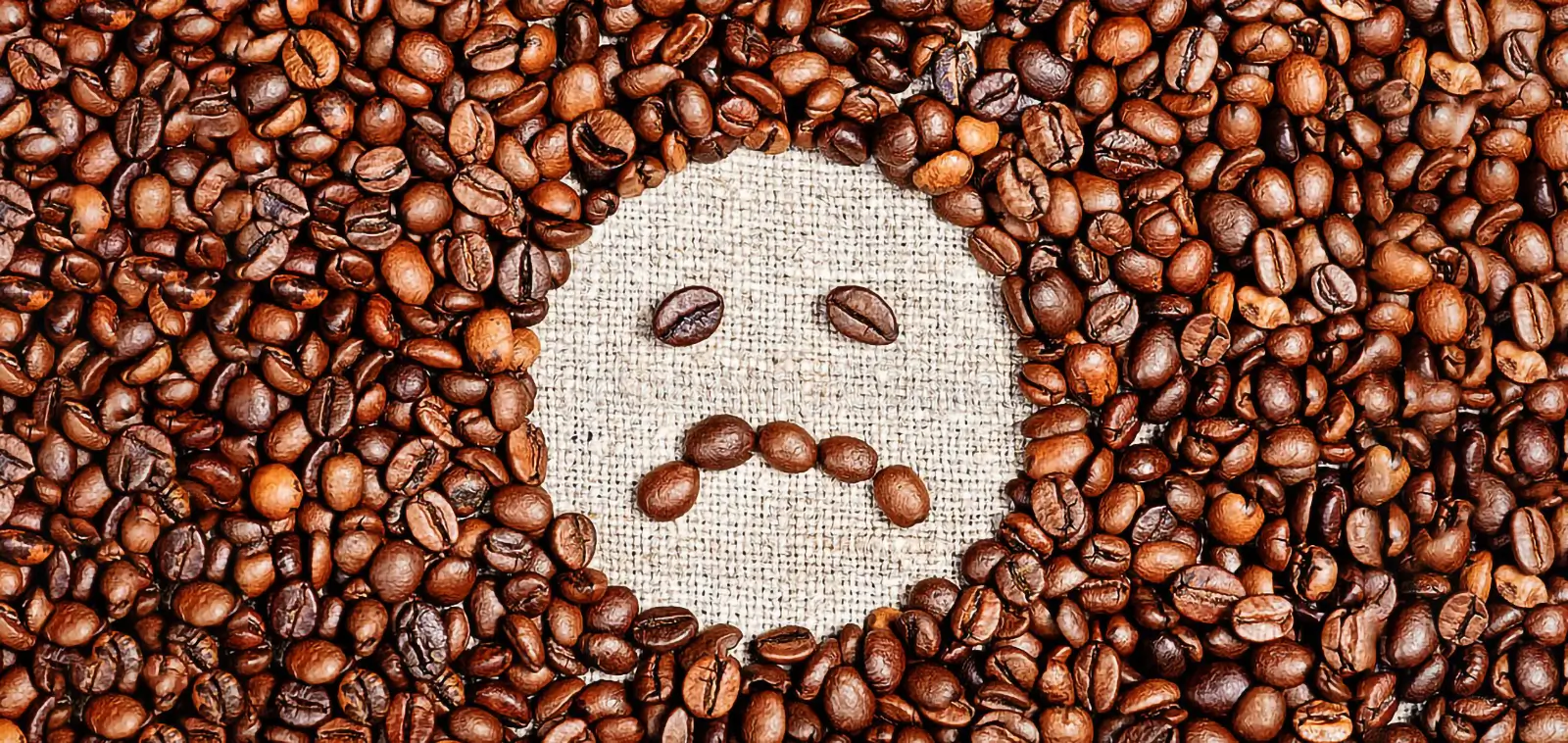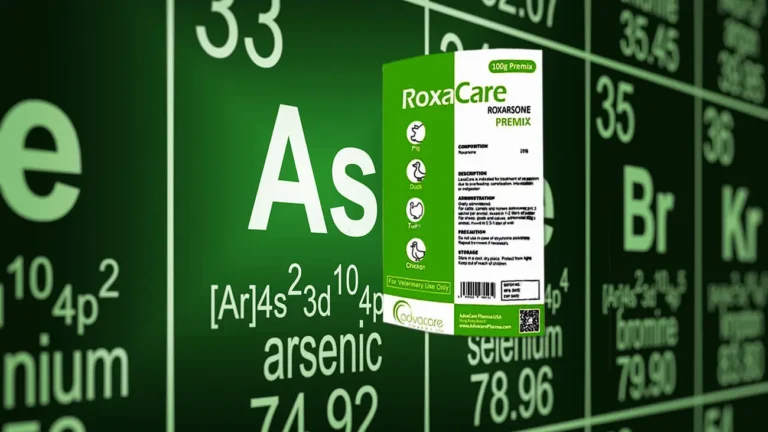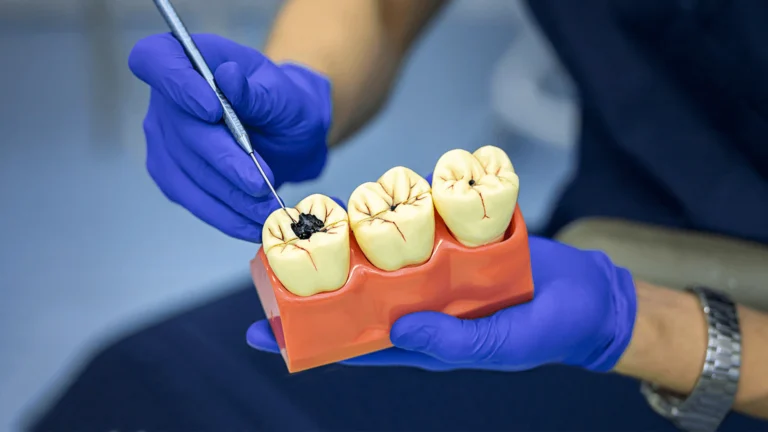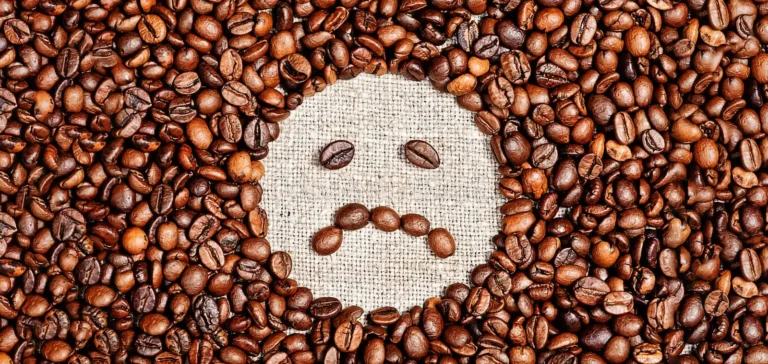Theobromine Benefits: Brain Boosting Without Anxiety
Theobromine is the secret behind chocolate’s effects on your mind and emotions. It can enhance your cognition and unlike caffeine, it lowers your stress levels.
Milos Pokimica
Written By: Milos Pokimica
Medically Reviewed by: Dr. Xiùying Wáng, M.D.
Updated December 21, 2025Key Takeaways:
– Theobromine has been shown to have several biological effects, including vasodilation, diuresis, cardiac stimulation, anti-inflammatory properties, central nervous system stimulation, bronchodilation, and mild psychoactive effects.
– Theobromine is less potent than caffeine in stimulating the central nervous system. Both of them work by blocking adenosine’s action.
– Caffeine peaks in blood 30-40 minutes after ingestion, and has a half-life of 2.5-6 hours while theobromine attains peak blood concentrations 2-3 hours after ingestion and has an estimated half-life of 7-12 hours.
– Cacao decreases salivary cortisol levels, stress, and anxiety and increases calmness and wakefulness, while coffee induces cortisol release, induces anxiety and stress, increases hypoglycemia, flight or fight response, and induces shakiness and tremors and affects more areas in the brain.
– Theobromine may be more beneficial for working memory and executive function than caffeine while caffeine may be more beneficial for attention and memory consolidation.
– It is speculated that theobromine does not show a rise in attention compared to caffeine because it did not raise stress levels as much as caffeine does. Stress levels are directly correlated to attention and reflexes. It actually reduced anxiety while caffeine reduced fatigue as a stress response.
– There is no official recommended daily intake, but a moderate intake is considered to be around 250-500mg per day.
The Basics: What is theobromine and where is it found?
When it comes to chocolate, most people think of its delicious taste and mood-boosting effects. However, did you know that chocolate contains a compound called theobromine (Ramli et al., 2000)?
Found primarily in cocoa, it has been shown to have similar effects to caffeine and a range of other benefits independently from a food source (Baggott et al., 2013).
In this article, we will unlock the secrets of theobromine, exploring its effects on humans and dogs, its presence in different types of chocolate and other foods, available products containing theobromine, and much more.
What is Theobromine?
It is a type of xanthine alkaloid. Xanthine alkaloid family encompasses a range of active compounds that stimulate the central nervous system (Ashihara et al., 2017).
Caffeine is also a xanthine alkaloid. In nature, these compounds have the purpose to protect the bean from insects.
They are natural insecticides (Ashihara et al., 2017).
They work by blocking adenosine receptors in the brain and with the right dosage are lethal to both insects and mammals. In mild dosages that are commonly consumed, they have the potential to improve cognitive function. This is a reason why cacao has a mood-boosting effect similar to coffee (Fusar-Poli et al.,2022).

In fact “theo-broma” means “food-of-the-gods” in Greek.
Summary:
Theobromine, similar to caffeine present in chocolate and other foods, offers potential cognitive benefits and mood-boosting effects similar to coffee due to its xanthine alkaloid properties.
Historical Background.
Cacao has been used for centuries by indigenous peoples in Central and South America, who discovered its stimulating effects on the human body. The earliest evidence of cacao consumption dates back to ancient Mayo-Chinchipe culture 5,300 years ago in the upper Amazon region of Ecuador which used it as a spiritual vehicle to higher realms of consciousness.
In 2006, wild Theobroma cacao was discovered by researchers from Globcal International in the Upper Saapure and Caura rivers. They have proposed that the Theobroma cacao genome likely has its origins at an altitude of 3,000 feet above sea level close to the jungle village of Esmeralda in Venezuela. The journey of this cocoa plant appears to have followed the path of the Orinoco River to the Casiquiare valley, then downriver into Rio Negro, and finally into the vast Amazon basin.
For ages, central and South American indigenous tribesmen have tapped into the incredible health benefits associated with consuming Cacao. It was revered by ancient Mayan & Aztec civilizations alike, which believed these beans were bestowed on them by their deities as an invaluable sacred relic. (Cook, 2023). In spiritual rituals and as medical remedies, these people knew well that higher doses could produce potent energy levels whilst boosting motivation & attention span through ingestion of Theobromine.

Fast forward to the colonial era when Spanish conquistadors realized how priceless this plant was (and still is) and brought it back to Europe as a revered trade commodity and luxury beverage. Eventually, it gained popularity throughout the world.
During the nineteenth century, scientists began to study theobromine as an extracted phytochemical and its effects on the human body.
Their findings demonstrated that this naturally occurring compound generates mild stimulation comparable to caffeine but takes longer to become active and also produces longer-lasting effects instead. Moreover, it displays diuretic characteristics, which can help to reduce fluid retention and lower blood pressure.
Summary:
Used for centuries by indigenous cultures for its mood-boosting and health benefits, theobromine gained global popularity after Spanish conquistadors introduced it to Europe, eventually sparking scientific study of its properties.
Sources of Theobromine.
| Source | Explanation | Dosage |
| Cocoa Beans | Theobromine is the primary methylxanthine found in cocoa beans. | Approximately 10-30 mg per 1 gram of cocoa powder (Moloney and Pálla, 2016). |
| Tea | Tea leaves, especially black tea, contain small amounts. | On a dry leaf weight basis, after three brews concentrations were highest in black teas (1.64 and 1.69 mg/g) and least in oolong teas (0.65 and 0.71 mg/g) (Hicks et al., 1996). |
| Cola Nuts | Cola nuts contain several methylxanthines, including theobromine, caffeine, and theophylline. | The amount in the kola nut varies depending on the species, but it is generally reported to be around 1.5-2%. This means that 1 gram of kola nuts would contain about 15-20 mg (Burdock et al., 2009). |
| Guarana Berries | Guarana berries contain high levels of caffeine and theobromine. | About 2-6 mg per gram of guarana powder. g (Da Silva Bittencourt et al., 2013). |
| Yerba Mate | Yerba mate contains several methylxanthines, including theobromine, caffeine, and theophylline. | The amount of it in yerba mate depends on the variety and quality of the plant, but it is generally reported to be around 0.2-0.9% of the dry weight. This means that 1 gram of dried yerba mate leaves would contain about 2-9 mg (Oellig et al., 2018). |
Cocoa Beans.
Cocoa beans are the primary source of theobromine.
The amount found in cocoa beans can vary on factors such as its type and how it has been processed. These variations may lead to fluctuations in the level of this compound between different batches or sources of cocoa. Generally, cocoa beans contain approximately 1-3% theobromine by weight (Moloney and Pálla, 2016). Cocoa powder and chocolate products derived from cocoa beans also contain theobromine, with levels ranging from 1000 to 3000 mg per 100 grams of cocoa powder (Moloney and Pálla, 2016).
Dark chocolate contains higher levels than milk chocolate. This is because dark chocolate contains a higher amount of cocoa compared to milk chocolate. So next time you’re craving something sweet, opt for some delicious dark chocolate.
Tea.
Tea leaves, particularly black tea, also contain small amounts of theobromine, On a dry leaf weight basis, total theobromine after three brews were highest in black teas (1.64 and 1.69 mg/g) and least in oolong teas (0.65 and 0.71 mg/g) (Hicks et al.,1996). An average tea bag is 1.5-2 grams. Tea is not a significant dietary source of theobromine as the amounts present are relatively small compared to cocoa products. The theobromine content of all teas was low, generally less than 4 mg per 6 oz.
Cola Nuts.
Cola nuts contain several different types of methylxanthines, including caffeine, theophylline, and theobromine, and are very potent. Each nut contains more caffeine than two large cups of American coffee. The amount of theobromine and caffeine in the kola nut varies depending on the species, but it is generally reported to be around 1.5-2% of each alkaloid by weight (Burdock et al., 2009). This means that 1 gram of kola nuts would contain about 15-20 mg of each. Cola nuts are used to flavor soft drinks and other beverages, and content in these products varies depending on the manufacturer and recipe.
Guarana Berries.
Guarana berries are a popular ingredient in energy drinks and supplements due to their high caffeine content. However, guarana berries also contain theobromine, with levels ranging from 0.2-0.6% of the dry weight. This means that 1 gram of dried guarana berries would contain about 2-6 mg of theobromine. In this study (Da Silva Bittencourt et al., 2013). guarana berries yielded caffeine = 12.2 mg/g, theobromine = 6.7 mg/g and total catechins = 4.4 mg/g.
Yerba Mate.
Yerba mate is a traditional South American beverage made from the leaves of the Ilex paraguariensis plant. Yerba mate contains several methylxanthines, including caffeine, theophylline, and theobromine. The amount of theobromine in yerba mate depends on the variety and quality of the plant, but it is generally reported to be around 0.2-0.9% of the dry weight. This means that 1 gram of dried yerba mate leaves would contain about 2-9 mg (Oellig et al., 2018).
Other Sources.
In addition to the sources listed in the table, theobromine is also present in several other plant-based foods and beverages, including:
- Carob: The seeds of the carob tree contain theobromine, though at lower levels than cocoa beans. Carob is sometimes used as a chocolate substitute and is also found in some health foods and supplements.
- Acai berries: Acai berries contain trace amounts, along with other antioxidants and nutrients.
- Maca root: Maca root is a traditional Andean food that is often used as a dietary supplement. It contains small amounts, along with other bioactive compounds.
It’s necessary to keep in mind the potential impact of consuming theobromine or other methylxanthines when ingesting these products because in most cases they come together and work synergistically. For example, cacao has both theobromine and caffeine. It has more theobromine than coffee but coffee has more caffeine than cacao.
If you’re considering taking supplements with high doses of this substance or have any concerns regarding its consumption, it’s best to talk to your healthcare provider first.
Summary:
Cocoa beans, especially dark chocolate, are the richest source of theobromine offering mild stimulation and potential health benefits, while other sources like tea, kola nuts, and guarana contain smaller amounts alongside other stimulants like caffeine. Remember, their effects can be synergistic, so be mindful of combined consumption.
Biological Effects of Theobromine.
| Biological Effects | Explanation | Dosage | |
| Vasodilation | Theobromine has been shown to cause vasodilation by inhibiting adenosine receptors and phosphodiesterases in the vascular smooth muscle (Xanthine Derivatives, 2012b). This leads to increased levels of cyclic AMP, which relaxes the blood vessels and lowers blood pressure. Vasodilation improves blood flow and can reduce blood pressure. The optimal dosage for vasodilation is not well established, but some studies suggest that it may be around 250 to 500 mg. | 250-500 mg | |
| Diuresis | It has mild diuretic effects, which can increase urine production and promote the elimination of excess fluids from the body (Baggott et al., 2013). | 500-1000 mg | |
| Cardiac stimulant | Theobromine significantly stimulates the production of nitric oxide (NO). | 500-1000 mg | |
| Anti-inflammatory | Theobromine has been shown to increase the production of inflammatory cytokines, including tumor necrosis factor-α and interleukin-6 in macrophages. It acts as an immune response stimulator via the NF-κB and MAPKs signaling pathways. Thus, it might have protective effects against inflammatory disorders (Lee et al., 2022). | 500-1000 mg | |
| Significant stimulation of the production of nitric oxide (NO). | Theobromine significantly stimulates the production of nitric oxide (NO). | 500-1000 mg | |
| Central nervous system stimulant | Theobromine has mild central nervous system stimulant effects that can increase alertness and attention (Baggott et al., 2013). | 100-200 mg | |
| Bronchodilator | It has been shown to have bronchodilator effects which can improve lung function and help relieve symptoms of asthma (Simons et al.,1985). | 10 mg/kg mild psychoactive effects. It has been shown to have mild psychoactive effects, including improved mood and reduced anxiety. However, the effects are weaker than those of caffeine and are not usually significant enough to cause adverse effects (Baggott et al., 2013). | 500-1000 mg |
Recent research indicates a plethora of biological effects, encompassing vasodilation, diuresis, cardiac stimulation, anti-inflammatory properties, central nervous system stimulation, bronchodilation, and even mild psychoactive effects. It’s worth noting, though, that these effects vary depending on the dosage administered, and in high amounts may trigger unpleasant outcomes such as tremors, nausea, vomiting, and irregular heartbeats.
My recommendation is to stick to whole food sources. There is plenty of theobromine in plain cacao powder and in most scenarios, you would not need to spend money on additional supplements.
Summary:
Theobromine offers diverse biological effects like vasodilation, improved mood, and immune stimulation, but optimal dosages vary and high doses can be counterproductive. Stick to whole food sources like cacao powder for safe and effective consumption.
Theobromine vs. Caffeine: A Comparative Analysis.
Structural difference.
Despite their structural similarities, they have different characteristics that make them unique. The main structural difference is that the latter has one less methyl group (-CH3) attached to its nitrogen atoms when compared to caffeine.
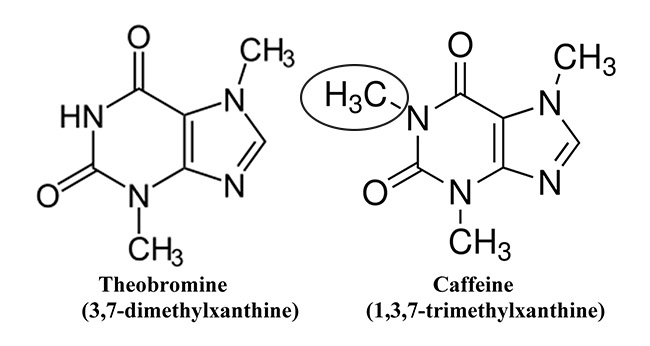
The main difference is that theobromine is less potent than caffeine mg per mg when it comes to stimulating the central nervous system but, it also does promote wakefulness, or accelerate body functions. Theoretically, we can take more of it than caffeine in mg to reach the same stimulating effect but there is a catch.
Theobromine has a longer half-life than caffeine.
This means that it takes more time to metabolize out the body or in other words it last longer with a lower peak value in a more steady manner of blood concentrations.
This can make it a more effective bronchodilator.
Caffeine metabolizes quickly peaks in the blood 30–40 minutes after ingestion, and has a half-life of 2.5–6 hours, (in this study was 5.7 hours (Statland and Demas., 1980)).
Theobromine takes longer to be eliminated from the body. It attains peak blood concentrations 2–3 hours after ingestion and has an estimated half-life of 7 –12 hours (Tarka, 1982).
Caffeine is highly water soluble, while theobromine is fat soluble.
This property gives it an extended duration of action when compared to caffeine. If we use exercise dosages it would not leave our system before bedtime in the same way that caffeine does. It takes 5 half-lives for a substance to clear out of the bloodstream.
Moreover, both can stimulate the release of brain chemicals such as dopamine leading to feelings of happiness or improved mood.
But caffeine has been shown to affect more regions of brain activity compared with its counterpart. This means that even if we take more theobromine it would never give us such as strong stimulating effect as coffee.
On the other hand, caffeine-strong and short-peak stimulation can result in a higher potential for addiction. Maybe the best approach would be to combine both of them in lower dosages.
Anecdotal reports are suggesting that individuals have become dependent on chocolate products containing high levels of cocoa solids (which contain theobromine) leaving feelings of craving after stopping their consumption (Scholey and Owen, 2013). Scientific data so far points mostly against this idea.
So far findings demonstrate a low potential for addiction (Baggott et al., 2013).
Summary:
While less potent than caffeine, theobromine offers sustained stimulation and potential bronchodilation due to its longer half-life and fat solubility making it a gentler alternative or a potential companion for lower-dose caffeine synergy. Both offer mood-boosting effects, but caffeine’s wider brain impact and shorter duration may lead to higher addiction potential with higher anxiety, cortisol, and epinephrine fight and flight response.
Neurobiological effects of theobromine.
Neurotransmitter systems.
The brain’s neurotransmitter systems are influenced by theobromine in interesting ways, leading to alterations in cognition and behavior. Studies have shown that it has an impact on adenosine receptors that help regulate sleep and wakefulness, making it a modulator of these functions.
By blocking adenosine receptors, it is able to increase alertness and promote better wakefulness (Valada et al., 2022), similar to caffeine but with less potency (Judelson et al., 2013).
Apart from its effects on adenosine receptors, it also exerts its influence on dopamine receptors in the brain, which are responsible for motivation, reward, and pleasure. This compound can actually enhance dopamine release in the brain, which could explain its mood-enhancing properties.
The ability of theobromine to positively affect dopamine levels may contribute to mediating stress response and promoting feelings of well-being.
In essence, theobromine holds promise as a supplement for individuals seeking greater cognitive function and improved mood. While not as potent as caffeine in terms of adenosine receptor inhibition, this natural substance offers unique benefits through its effects on critical neurotransmitters like dopamine.
Summary:
While less potent than caffeine, theobromine’s influence on adenosine and dopamine receptors offers the potential for improved alertness, mood, and cognitive function, making it a gentler alternative or a mood-boosting addition to lower-dose caffeine.
Theobromine effect on dopamine.
Dopamine is the main driving force for caffeine usage and this is not what most people realize. In the human brain, caffeine, at doses typically consumed, increases the availability of DA D2/D3 dopamine receptors (Volkow et al., 2015). Caffeine enhances dopamine (DA) signaling in the brain, which it does predominantly by antagonizing adenosine A2A receptors (A2AR).
The main problem with coffee consumption is exactly this addiction to its dopamine-releasing effects.
People chasing dopamine highs from coffee will have a tendency to overdo its consumption and as a side effect create constant stress in their lives by depriving their brains of oxygen forcing the body into adaptation mode. The problem is that there is a limit. This is why some people experience tremors, low blood sugar, and jerkiness from coffee.
Theobromine and Caffeine, work by blocking the action of adenosine, a neurotransmitter that promotes sleep and suppresses arousal, and also in high dosages suppresses blood flow to the brain. This creates oxygen deprivation and in order to avoid brain cell death body raises blood pressure, cortisol, epinephrine, and other stress hormones this is what is called fight or flight mode. This might be good if you using caffeine as a pre-workout or you are chased by a tiger but in chronic every day excessive exposure would have serious health effects.
Ideally, we should choose a stimulant that has a dopamine-releasing effect without putting us into stress flight or fight mode. And this is where theobromine might help.
Summary:
While both coffee and theobromine offer stimulation by blocking sleep-inducing adenosine, theobromine’s gentler dopamine boost avoids the potential stress and addiction associated with chronic coffee’s stronger dopamine-fueled highs and jitters.
Effects on Mood.
Dopamine also plays a role in mood regulation, reward perception, and motivation.
It is important to also consider its potential risks and interactions with other drugs or supplements that may affect dopamine levels, such as antidepressants, antipsychotics, or stimulants.
A review by Scholey and Owen, 2013 found that consumption of dark chocolate containing cocoa polyphenols improved overall mood and increased self-reported calmness compared to a placebo group in five studies from eight that met the inclusion criteria. Regarding cognitive function, eight studies (in six articles) met the criteria for inclusion, of which three revealed clear evidence of cognitive enhancement (following cocoa flavanols and methylxanthine). These effects may result from increased dopamine release due to inhibition of adenosine receptors.
The benefit here is that unlike coffee consumption cacao polyphenols improved overall mood and increased self-reported calmness.
In this study cortisol (stress hormone) was measured after chocolate consumption (Tsang et al., 2019). After ingestion of high-polyphenol dark chocolate, there was a significant reduction in total daily cortisol, morning cortisol, and the cortisol/cortisone ratio. Consequently, this small-scale study suggests that polyphenol-rich dark chocolate may decrease salivary cortisol levels in adult participants. The authors observed lower cortisol levels and improved subjective stress ratings among subjects consuming high-cocoa content. These adjustments could be due to the inhibition of 11β-hydroxysteroid dehydrogenase type 1 activity and merit further exploration.
On the other hand, coffee is known to be their 1 stressor. While cacao induces calmness and decreases cortisol, coffee will induce cortisol release and hypoglycemia, and tremors. Caffeine is known as a cortisol stimulant. Also in chronic coffee drinkers who consume caffeine on a daily basis cortisol responses to caffeine do get reduced, but never get fully eliminated (Lovallo et al., 2005).
Summary:
Cacao’s gentler dopamine boost, with its stress-reducing polyphenols and lower cortisol impact, offers calmer alertness and potential cognitive benefits compared to coffee, making it a mood-friendly and potentially healthier choice.
Comparison of Theobromine and Caffeine Effects on Cognitive Performance.
Research suggests that while consumption of high doses of pure theobromine may cause mild side effects such as nausea or tremors (albeit only part as severe when compared to caffeine); it does not seem likely to be addictive on its own. Daily intake from common chocolate sources is usually too low to be harmful or create an addiction, although habits such as consuming large amounts of any food product should be monitored carefully.
Both have their own unique cognitive-enhancing effects. Theobromine may be more beneficial for working memory and executive function, while caffeine may be more beneficial for attention and memory consolidation. Thus, let us enjoy our chocolate and coffee in moderation, relishing the diverse benefits they have to offer.
However, the effects of these compounds on cognitive function have not been extensively studied in comparison to each other.
Summary:
While both theobromine and caffeine offer cognitive benefits, theobromine shines for working memory and executive function, while caffeine excels in attention and memory consolidation.
Theobromine vs Caffeine Results.
The following table summarizes the results of studies that have compared the cognitive effects in human subjects:
| Measure | Theobromine | Caffeine |
| Attention | No significant effects | Improved sustained attention, reaction time, and alertness (McLellan et al., 2016) |
| Memory | Improved working memory (Scholey et al, 2010) | Improved memory consolidation (Klaassen et al., 2013) |
| Executive Function | Improved cognitive flexibility and inhibition (Scholey et al, 2010) | Improved response inhibition and mental flexibility (Kim et al., 2021) |
| Mood | Improved mood and reduced anxiety (Scholey et al, 2010) | Improved mood and reduced fatigue (McLellan et al., 2016) |
Upon examining the table data, it’s evident that both have been proven to boost cognitive function. However, the extent of their effects varies depending on the cognitive task assigned and the quantity administered.
However, it’s worth noting that unlike coffee which can produce palpitations or anxiety if too much is consumed and this usually means just two to three coffees a day, there are very few side effects associated with consuming it in moderate amounts. Studies suggest LD50 (lethal dose) for humans hovers around 1 gram per kilogram body weight quantity indicating considerable safety levels compared to something like coffee and also caffeine from green tea and energy drinks.
Furthermore consuming dark chocolate may lead to a wide range of additional health benefits because of the high antioxidant content and presence of flavanols. Cacao is also one of the most nutrient-dense food sources and an excellent source of magnesium.
The reason why theobromine did not show a rise in attention and this is just my speculation is because it did not raise the stress level as much as caffeine. Stress level is directly correlated to attention and reflexes. It actually reduced anxiety while caffeine induced fatigue as a stress response.
Summary:
While caffeine requires caution for potential side effects and can induce fatigue as a result of stress response, theobromine boasts a higher safety margin and potential extra health benefits from dark chocolate.
How Does Theobromine Affect Athletic Performance?
Some studies have indicated improved endurance, increased oxygen uptake, and delayed fatigue. However, the evidence for these claims remains somewhat limited. Some of the possible benefits include:
- Improving mood and motivation by increasing dopamine levels
- Enhancing blood flow and oxygen delivery to the muscles by dilating blood vessels
- Reducing fatigue and improving endurance by blocking adenosine receptors
- Providing a mild stimulant effect that is less jittery and more stable than caffeine
However, these effects are not very pronounced.
There is also the potential for overstimulation and jitteriness when taken in large amounts or consumed by people with a low tolerance. The problem is that if you overdo it, it has a longer half-life than caffeine. It will linger in your system for an extended period. This accumulation could result in sustained and prolonged effects that may be noticeable even hours after consumption.
If you overdo it it may lead to cardiovascular complications like elevated heart rate and blood pressure. If you have pre-existing heart conditions or hypertension, it’s advisable to steer clear of supplements that contain theobromine or consult with your healthcare provider before taking them.
The optimal dose for pre-workout purposes is not well established, but some sources suggest that it may be around 250 to 500 mg per day.
There are two main and scientifically proven benefits of exercise.
1. Central Nervous System Stimulation
Both caffeine and theobromine positively influence brain function and can stimulate mood-regulating nerves resulting in higher learning capabilities, reaction time, attention capacity, and muscle contraction intensity needed for athletes during training or competitions and are not on a doping list of banned substances.
The body assimilates caffeine much quicker than it does with theobromines and this is a primary reason why caffeine is used as a pre-workout supplement much more. Also, evidence shows a lower stimulating effect of cocoa extract containing up to %10 of the total methylxanthines when compared with an equal dosage of pure synthetic caffeine because caffeine is a more effective nerve stimulator. It affects more areas in the brain.
2. Exercise Metabolism
Another positive impact on athletic performance comes from its ability to affect energy metabolism. It can trigger fat oxidation by directly acting on adipose (fat) tissue and help provide energy during exercise.
According to studies, there might be a promising positive impact on the browning of white adipocytes (turning white fat into brown). It might also improve lipid catabolism in both cultured brown and white adipocytes through its activation of β-adrenergic signaling and AMPK (Jang et al., 2018).
Therefore, incorporating Theobromine into one’s diet is a practical approach to trigger thermogenesis and enhance systematic lipid metabolism, effectively safeguarding against metabolic disorders such as obesity. Despite its potential benefits, it has yet to be fully utilized as an effective weight-loss supplement due to limitations found in current research studies.
While studies suggest potential benefits on endurance performance and oxygen uptake it is important to note that conclusive evidence remains limited. There is currently insufficient research to recommend loading up heavily on high doses of pure extracted and isolated supplemental theobromine which may be impracticable due to issues such as the relative cost-benefit ratio. Compared to natural dietary sources containing lower concentrations but still containing enough to show benefits the supplements are not really necessary. There are also other beneficial health effects of cacao outside of the sports context as well.
Summary:
For athletes seeking a gentler, less jittery stimulant, theobromine offers potential boosts in mood, blood flow, and fat burning, but research on its performance benefits is still limited. Stick to natural sources like dark chocolate and prioritize moderation for safe, sustained energy without relying heavily on supplements.
Theobromine Containing Products.
There are alternatives like chocolate that are free of theobromine available for individuals who experience allergies or heightened sensitivity to stimulants.
It can also be used in food and drink products as a natural ingredient. Some of the most popular products include:
1. Pre-workout supplements: many pre-workouts contain added caffeine to boost performance, but they may also contain theobromine.
2. Dark Chocolate/Cocoa Powder: These can provide an excellent source if someone is seeking out higher doses.
3. Supplements: Many people take it as a standalone supplement to avoid consuming extra calories.
How to Choose and Use Chocolate Products that Contain Theobromine
If you are interested in enjoying the benefits of theobromine, you may want to consider adding some chocolate products to your diet. However, not all chocolate products are created equal. Here are some tips on how to choose and use the chocolate products:
- Look for dark chocolate with a high cocoa content. The higher the cocoa content, the higher the theobromine content. Ideally, you should aim for dark chocolate with at least 70% cocoa solids. For example, 85% dark chocolate contains about 200 mg per ounce (28 grams), while milk chocolate contains only about 60 mg per ounce ( Moloney and Pálla, 2016 ).
- Avoid chocolate products with added sugar, milk, or other ingredients that may reduce the health benefits of cocoa. Sugar and milk can interfere with the absorption of theobromine and other antioxidants in cocoa. They can also add extra calories and fat to your diet. Look for chocolate products that are vegan, organic, and minimally processed.
- Consume chocolate products in moderation. While it has many positive effects on health and cognition, it can also cause side effects if consumed in excess. Too much can cause nausea, vomiting, tremors, irregular heartbeat, and insomnia. The recommended daily intake is around 250 to 500 mg per day ( Baggott et al., 2013 ). This means that you should limit your consumption of dark chocolate to about one or two ounces (28 to 56 grams) per day.
By following these tips, you can choose and use chocolate products in a healthy and delicious way. You can enjoy the benefits of this natural compound while satisfying your sweet tooth and supporting your vegan lifestyle.
Summary:
For theobromine benefits, opt for dark chocolate with at least 70% cocoa, avoid sugary additives, and stick to moderate portions (1-2 oz/day).
The Effects of Theobromine on Sleep Quality.
Is hot chocolate before bed bad or good for you?
Have you ever heard of REM Sleep Behavior Disorder (RBD)?
The National Sleep Foundation recommends avoiding chocolate as well as coffee, tea, and soft drinks before bedtime.
Research investigating how theobromine specifically affects sleep quality is limited however some studies suggest that consuming cocoa-containing products can have negative effects on sleep onset latency although more evidence is needed. Some experts argue that moderate levels of caffeine intake including those found in chocolate: 1-3mg/kg of body weight per day do not negatively affect sleep quality for an adult but further study will be needed to help to clarify these findings. If you are a chronic caffeine drinker then theobromine might not have such a strong effect on your sleep quality. More research is needed.
There was one recent case study that explored the relationship between chocolate consumption and RBD (Vorona and Ware, 2002).
RBD is a condition where people act out their dreams during REM sleep. It’s quite rare, affecting only 0.5 to 1 percent of adults. Unfortunately, RBD can be associated with other neurological disorders like Parkinson’s disease, Lewy body dementia, and multiple system atrophy. It’s a pretty spooky condition that can cause people to lash out in their sleep.
In this case study, a 73-year-old man noticed his RBD symptoms worsening after eating chocolate. He underwent a sleep test and was found to have increased muscle activity during REM sleep after consuming chocolate compared to a night without it. So what’s the deal, does chocolate really make RBD worse?
Unfortunately, this study has some limitations. For one, it didn’t have a control group. It also couldn’t determine whether chocolate actually caused RBD or just triggered it in this particular patient. However, this study does provide us with an observation that could suggest that chocolate contains substances that worsen RBD.
The authors of the study recommend avoiding chocolate before bedtime. This might not be great news for chocolate lovers out there, but it’s important to prioritize getting restful sleep over indulging in sweet treats.
An animal model analysis of circadian sleep cycle data in D. melanogaster, for relative amounts of theobromine to caffeine (8:1 ratio) found in chocolate, suggests that theobromine disrupts sleep, while caffeine plays only a limited role. Theobromine-fed flies register 30% less total sleep at night versus the control group, while for caffeine-fed flies, only a 4% reduction in sleep is observed [PDF].
But this can also be used to our benefit if we consume the cacao in the morning.
It can help us regulate our Circadian Rhythm and this is what they found in this study (Garbarino et al., 2022).
According to (Garbarino et al., 2022) we all have experienced the negative impact of desynchronization on our work ability, daily life, and well-being in our lives. The tight rhythms imposed by work, social life, and technology can lead to the desynchronization of our internal clocks with external synchronizers. This can have a devastating effect on our psycho-physical performance, leaving us feeling sluggish and unproductive. One of the reasons why people are so addicted to caffeine.
According to (Garbarino et al., 2022) taking small amounts of chocolate at breakfast in the morning can help speed up the resynchronization of our internal biological central and peripheral clocks with the main external synchronizers, such as the light-dark cycle and nutrition-fasting cycle. In layman’s terms, chocolate helps regulate our circadian rhythms and improves our cognitive function and mood.
According to (Garbarino et al., 2022) Incorporating chocolate into our diet in compliance with chrononutrition has even more benefits. Chrono nutrition is the idea that what we eat and when we eat it affects our internal clocks. By consuming chocolate in the morning at breakfast during our active phase, we not only resynchronize our internal clocks but also provide ourselves with sustained energy for the day ahead.
Of course, we cannot expect to consume copious amounts of chocolate and see miraculous results. Like with anything else, moderation is key. Small amounts of dark chocolate (containing at least 70% cocoa solids) are best for achieving these benefits.
In conclusion, incorporating chocolate into our diet in compliance with chrono nutrition could be a simple yet effective strategy for reducing the negative effects of desynchronization on our daily lives.
| Theobromine Effects on sleep quality (in the morning) | Dosage |
| Increased alertness | 100-200 mg |
| Decreased sleepiness | 100-200 mg |
| Delayed onset of sleep | 500-1000 mg |
| Decreased total sleep time | 500-1000 mg |
| Decreased deep sleep | 500-1000 mg |
| Increased rapid eye movement (REM) sleep | 500-1000 mg |
| Increased wakefulness during sleep | 500-1000 mg |
Summary:
While dark chocolate in the morning may boost alertness and regulate sleep rhythms, avoid it near bedtime as theobromine’s sleep-disrupting effects could worsen conditions like REM sleep behavior disorder and delay sleep. Choose moderation (70% cocoa, 100-200mg) and stick to mornings.
Theobromine Toxicity.
When it comes to toxicity, the right dosage may vary based on a host of individual factors. Researchers face a significant challenge in understanding how much should be consumed and who can benefit from it the most. There are several factors that can influence how our bodies process this substance, making it difficult to establish a one-size-fits-all recommendation.
Individual differences such as age, weight, genetics, or lifestyle can impact how our body metabolizes this chemical compound. Even other substances taken alongside it may alter its effects.
Nevertheless, adhering to some general pointers can help minimize potential toxicity risks.
A maximal recommended intake of caffeine, which is more potent, has been outlined by the US Food and Drug Administration at 400mg per day. There is no official maximal recommended intake of theobromine, as it is not an essential nutrient. However, some sources suggest that a moderate intake is around 250 to 500 mg per day. A high intake is considered to be above 500 mg per day, which can cause adverse effects in some people.
As a supplement, the recommended daily allowance is 250 to 500 mg per day.
However, this limit might still be too high for certain people, especially those sensitive to stimulants or dealing with pre-existing medical conditions. It is generally advised that you avoid consuming large amounts all at once until you find your tolerance level.
Table of Theobromine Toxicity
| Cardiovascular effects | It has been shown to cause an increase in heart rate and blood pressure in some individuals, especially those who are sensitive to caffeine. Ingesting high doses can cause arrhythmias and even heart failure in some cases. | Symptoms of cardiovascular effects can occur at doses as low as 20 mg/kg in humans. |
| Neurological effects | It can have both stimulant and depressant effects on the central nervous system. At low doses, it can cause feelings of alertness and euphoria, but at high doses, it can cause anxiety, restlessness, and even seizures. | Symptoms of neurological effects can occur at doses as low as 50-100 mg in humans, but severe toxicity is typically only seen at much higher doses. |
| Gastrointestinal effects | Ingesting large amounts can cause nausea, vomiting, and diarrhea in some individuals. This can occur because theobromine can irritate the lining of the stomach and intestines. It can also affect the smooth muscle contractions of the digestive tract, causing cramps and spasms. | Symptoms of gastrointestinal effects typically start at doses of 200-300 mg in sensitive individuals. |
| Renal effects | It has been shown to increase urine production and may have a diuretic effect in some individuals. However, at high doses, it can cause kidney damage. | |
| Reproductive effects | It has been shown to have both positive and negative effects on reproductive health. In some studies, it has been shown to increase sperm count and motility in males, while in others it has been shown to have negative effects on female fertility. | The dosage at which it can have reproductive effects is not well established, but it is believed to be higher than the doses typically associated with other types of toxicity. |
Drugs and medications that can interact with theobromine.
| Drugs or Medications | Explanation of the Effect | Dosage |
| Monoamine oxidase inhibitors (MAOIs) | Theobromine has been shown to inhibit the activity of MAO, an enzyme that is involved in the breakdown of certain neurotransmitters. When combined with MAOIs, which are a class of antidepressant drugs that also inhibit MAO activity, it can increase the levels of these neurotransmitters and cause potentially dangerous side effects such as high blood pressure, fever, and seizures. | The dosage at which it can interact with MAOIs is not well established, but it is recommended to avoid consuming large amounts of theobromine-containing foods or supplements while taking MAOIs. |
| Stimulant medications | It has stimulant properties and can increase heart rate and blood pressure. When combined with other stimulant medications such as caffeine, theobromine can increase the risk of cardiovascular side effects such as arrhythmias, heart attack, or stroke. | The dosage at which it can interact with stimulant medications varies depending on the specific medication and individual factors such as age, weight, and overall health. It is important to consult with a healthcare provider before combining theobromine-containing foods or supplements with any stimulant medications. |
| Sedative medications | It has also been shown to have sedative effects at higher doses. When combined with other sedative medications such as benzodiazepines or antipsychotics, it can increase the risk of central nervous system depression, leading to symptoms such as drowsiness, confusion, and difficulty breathing. | The dosage at which it can interact with sedative medications also varies depending on the specific medication and individual factors. It is important to consult with a healthcare provider before combining theobromine-containing foods or supplements with any sedative medications. |
Summary:
Individual factors like age and pre-existing conditions affect safe dosage, so stick to moderate amounts (250-500mg/day) and avoid combining it with certain medications like MAOIs and stimulants.
Theobromine toxicity in dogs.
While humans can metabolize theobromine relatively quickly, dogs cannot. This means that even a small amount of chocolate can cause serious problems for your furry friend.

The consumption of chocolate by pets (especially dogs) is widely known to be dangerous, and this is mainly due to theobromine poisoning. Dogs metabolize theobromine slowly, which means that it can build up in their system over time, potentially reaching toxic levels.
Theobromine is toxic to dogs much more than to humans. Carnivores that did not consume beans like us in their evolution have much lower threshold levels for toxicity. Theobromine consumption in dogs and cats can lead to a range of symptoms and can be potentially life-threatening if not treated promptly. It is important for dog and cat owners to be aware of the symptoms of toxicity and to seek veterinary care immediately if their dog shows any signs of toxicity.
The onset of symptoms can occur within a few hours of ingestion, and the severity and duration of symptoms can vary depending on the amount that is consumed.
In severe cases, toxicity can even lead to coma and death.
To prevent toxicity in dogs, it’s important to keep all Theobromine-containing foods and beverages out of their reach. In addition, it’s important to be aware of the potential sources of Theobromine in your home and surroundings, such as cocoa mulch and certain types of medications.
| Level of Theobromine | Symptoms in Dogs |
| 20mg/kg | Mild gastrointestinal symptoms (vomiting, diarrhea) |
| 40-50mg/kg | Restlessness, muscle tremors |
| 60-90mg/kg | Abnormal heart rate, high blood pressure |
| 200mg/kg | Seizures, internal bleeding |
| 250-500mg/kg | Cardiac arrest, death |
| Food Source | Symptoms in Dogs | Amount of Food Needed for Toxicity |
| Dark chocolate | Vomiting, diarrhea, hyperactivity, tremors, seizures, death | 14 grams of dark chocolate per kilogram of dog’s body weight |
| Milk chocolate | Vomiting, diarrhea, hyperactivity, tremors, seizures | 24 grams of milk chocolate per kilogram of dog’s body weight |
| Semi-sweet chocolate | Vomiting, diarrhea, hyperactivity, tremors, seizures | 9 grams of semi-sweet chocolate per kilogram of dog’s body weight |
| Baking chocolate | Vomiting, diarrhea, hyperactivity, tremors, seizures, death | 2 grams of baking chocolate per kilogram of dog’s body weight |
If you have a small dog or a cat, one single piece of baking chocolate can kill them with the most excruciating pain. Keep in mind that there is also caffeine in cacao and caffeine is even more toxic to pets. A medium-sized dog weighing 50 pounds would only need to eat 1 ounce of baker’s chocolate, or 9 ounces of milk chocolate, to potentially show signs of poisoning.
There are no readily accessible diagnostic tests for chocolate intoxication, so your veterinarian will rely on your information and observation to determine if your dog has been poisoned by chocolate. It is important to seek medical attention as soon as you suspect that your dog has eaten chocolate or shows any signs of poisoning.
The best way to prevent toxicity is to keep chocolate and cocoa products away from your dog. Store them in a secure place that your dog cannot access, such as a high shelf or a locked cabinet. Do not leave chocolate wrappers or crumbs on the floor or in the trash where your dog can find them. Do not feed your dog any chocolate or share your chocolate treats with them. If you have cocoa bean hull mulch in your garden, make sure your dog does not eat it or dig in it. If you suspect that your dog has eaten chocolate or cocoa products, contact your veterinarian or Pet Poison Helpline immediately.
Summary:
For dog owners: Chocolate is deadly for dogs! Keep all cocoa products out of reach as a small amount can cause tremors, seizures, and even death. Act fast and seek vet help immediately if you suspect your dog ate any chocolate.
In the video below, you’ll discover the nootropic benefits of Cacao or dark chocolate. Including why we use Cacao as a nootropic, recommended dosage, side effects, and clinical research.
Your Brain On Chocolate.
FAQ
References:
- Ramli, N., Rahman, S., Hassan, O., Mohd Yatim, A., Said, M., Lim, L., & Ng, W. (2000). Caffeine and theobromine levels in chocolate couverture and coating products. Malaysian journal of nutrition, 6(1), 55–63. [PubMed]
- Baggott, M. J., Childs, E., Hart, A. B., de Bruin, E., Palmer, A. A., Wilkinson, J. E., & de Wit, H. (2013). Psychopharmacology of theobromine in healthy volunteers. Psychopharmacology, 228(1), 109–118. https://doi.org/10.1007/s00213-013-3021-0
- Ashihara, H., Mizuno, K., Yokota, T., & Crozier, A. (2017). Xanthine Alkaloids: Occurrence, Biosynthesis, and Function in Plants. Progress in the chemistry of organic natural products, 105, 1–88. https://doi.org/10.1007/978-3-319-49712-9_1
- Fusar-Poli, L., Gabbiadini, A., Ciancio, A., Vozza, L., Signorelli, M. S., & Aguglia, E. (2022). The effect of cocoa-rich products on depression, anxiety, and mood: A systematic review and meta-analysis. Critical reviews in food science and nutrition, 62(28), 7905–7916. https://doi.org/10.1080/10408398.2021.1920570
- Cook, L. R. (2023, April 14). Cacao | Description, Cultivation, Pests, & Diseases. Encyclopedia Britannica. https://www.britannica.com/plant/cacao
- Moloney, A. P., & Pálla, G. (2016b). Cocoa: Production, Chemistry, and Use. In Elsevier eBooks (pp. 185–190). https://doi.org/10.1016/b978-0-12-384947-2.00177-x
- Hicks, M. B., Hsieh, Y., & Bell, L. N. (1996b). Tea preparation and its influence on methylxanthine concentration. Food Research International, 29(3–4), 325–330. https://doi.org/10.1016/0963-9969(96)00038-5
- Burdock, G. A., Carabin, I. G., & Crincoli, C. M. (2009). Safety assessment of kola nut extract as a food ingredient. Food and chemical toxicology : an international journal published for the British Industrial Biological Research Association, 47(8), 1725–1732. https://doi.org/10.1016/j.fct.2009.04.019
- Da Silva Bittencourt, Leonardo, et al. “The Protective Effects of Guaraná Extract (Paullinia Cupana) on Fibroblast NIH-3T3 Cells Exposed to Sodium Nitroprusside.” Food and Chemical Toxicology, vol. 53, Elsevier BV, Mar. 2013, pp. 119–25. https://doi.org/10.1016/j.fct.2012.11.041.
- Oellig, C., Schunck, J., & Schwack, W. (2018). Determination of caffeine, theobromine and theophylline in Mate beer and Mate soft drinks by high-performance thin-layer chromatography. Journal of chromatography. A, 1533, 208–212. https://doi.org/10.1016/j.chroma.2017.12.019
- Xanthine Derivatives. (2020). In LiverTox: Clinical and Research Information on Drug-Induced Liver Injury. National Institute of Diabetes and Digestive and Kidney Diseases. [PubMed]
- Lee, H. W., Choi, I. W., & Ha, S. K. (2022). Immunostimulatory Activities of Theobromine on Macrophages via the Activation of MAPK and NF-κB Signaling Pathways. Current issues in molecular biology, 44(9), 4216–4228. https://doi.org/10.3390/cimb44090289
- Kiani, A. K., Bonetti, G., Medori, M. C., Caruso, P., Manganotti, P., Fioretti, F., Nodari, S., Connelly, S. T., & Bertelli, M. (2022). Dietary supplements for improving nitric-oxide synthesis. Journal of preventive medicine and hygiene, 63(2 Suppl 3), E239–E245. https://doi.org/10.15167/2421-4248/jpmh2022.63.2S3.2766
- Simons, F. E. R., Becker, A. B., Simons, K. J., & Gillespie, C. A. (1985). The bronchodilator effect and pharmacokinetics of theobromine in young patients with asthma. Journal of Allergy and Clinical Immunology, 76(5), 703-707. https://doi.org/10.1016/0091-6749(85)90674-8
- Statland, B. E., & Demas, T. J. (1980). Serum caffeine half-lives. Healthy subjects vs. patients having alcoholic hepatic disease. American journal of clinical pathology, 73(3), 390–393. https://doi.org/10.1093/ajcp/73.3.390
- Tarka S. M., Jr (1982). The toxicology of cocoa and methylxanthines: a review of the literature. Critical reviews in toxicology, 9(4), 275–312. https://doi.org/10.3109/10408448209037495
- Scholey, A., & Owen, L. (2013). Effects of chocolate on cognitive function and mood: a systematic review. Nutrition reviews, 71(10), 665–681. https://doi.org/10.1111/nure.12065
- Valada, P., Alçada-Morais, S., Cunha, R. A., & Lopes, J. P. (2022). Thebromine Targets Adenosine Receptors to Control Hippocampal Neuronal Function and Damage. International journal of molecular sciences, 23(18), 10510. https://doi.org/10.3390/ijms231810510
- Judelson, D. A., Preston, A. G., Miller, D. L., Muñoz, C. X., Kellogg, M. D., & Lieberman, H. R. (2013). Effects of theobromine and caffeine on mood and vigilance. Journal of clinical psychopharmacology, 33(4), 499–506. https://doi.org/10.1097/JCP.0b013e3182905d24
- Volkow, N. D., Wang, G., Logan, J., Alexoff, D., Fowler, J. S., Thanos, P. K., Wong, C., Casado, V., Ferré, S., & Tomasi, D. (2015b). Caffeine increases striatal dopamine D2/D3 receptor availability in the human brain. Translational Psychiatry, 5(4), e549. https://doi.org/10.1038/tp.2015.46
- Scholey, A., & Owen, L. (2013). Effects of chocolate on cognitive function and mood: a systematic review. Nutrition reviews, 71(10), 665–681. https://doi.org/10.1111/nure.12065
- Tsang, C., Hodgson, L., Bussu, A., Farhat, G., & Al-Dujaili, E. (2019). Effect of Polyphenol-Rich Dark Chocolate on Salivary Cortisol and Mood in Adults. Antioxidants (Basel, Switzerland), 8(6), 149. https://doi.org/10.3390/antiox8060149
- Lovallo, W. R., Whitsett, T. L., al’Absi, M., Sung, B. H., Vincent, A. S., & Wilson, M. F. (2005). Caffeine stimulation of cortisol secretion across the waking hours in relation to caffeine intake levels. Psychosomatic medicine, 67(5), 734–739. https://doi.org/10.1097/01.psy.0000181270.20036.06
- Scholey, A., French, S. J., Morris, P. J., Kennedy, D. N., Milne, A. L., & Haskell, C. F. (2010b). Consumption of cocoa flavanols results in acute improvements in mood and cognitive performance during sustained mental effort. Journal of Psychopharmacology, 24(10), 1505–1514. https://doi.org/10.1177/0269881109106923
- McLellan, T. M., Caldwell, J. C., & Lieberman, H. R. (2016b). A review of caffeine’s effects on cognitive, physical and occupational performance. Neuroscience & Biobehavioral Reviews, 71, 294–312. https://doi.org/10.1016/j.neubiorev.2016.09.001
- Klaassen, E. B., De Groot, R. H. M., Evers, E. a. T., Snel, J., Veerman, E. C. I., Ligtenberg, A. J. M., Jolles, J., & Veltman, D. J. (2013b). The effect of caffeine on working memory load-related brain activation in middle-aged males. Neuropharmacology, 64, 160–167. https://doi.org/10.1016/j.neuropharm.2012.06.026
- Kim, H., Kang, S. K., Kim, S., Kim, S. H., Hwang, J., Kim, J., Han, K., & Kim, B. J. (2021b). Drinking coffee enhances neurocognitive function by reorganizing brain functional connectivity. Scientific Reports, 11(1). https://doi.org/10.1038/s41598-021-93849-7
- Jang, M. J., Kang, N. J., Mukherjee, S., & Yun, J. W. (2018b). Theobromine, a Methylxanthine in Cocoa Bean, Stimulates Thermogenesis by Inducing White Fat Browning and Activating Brown Adipocytes. Biotechnology and Bioprocess Engineering, 23(6), 617–626. https://doi.org/10.1007/s12257-018-0434-y
- Vorona, R. D., & Ware, J. C. (2002). Exacerbation of REM sleep behavior disorder by chocolate ingestion: a case report. Sleep medicine, 3(4), 365–367. https://doi.org/10.1016/s1389-9457(02)00008-4
- Garbarino, S., Garbarino, E., & Lanteri, P. (2022). Cyrcadian Rhythm, Mood, and Temporal Patterns of Eating Chocolate: A Scoping Review of Physiology, Findings, and Future Directions. Nutrients, 14(15), 3113. https://doi.org/10.3390/nu14153113
Do you have any questions about nutrition and health?
I would love to hear from you and answer them in my next post. I appreciate your input and opinion and I look forward to hearing from you soon. I also invite you to follow us on Facebook, Instagram, and Pinterest for more diet, nutrition, and health content. You can leave a comment there and connect with other health enthusiasts, share your tips and experiences, and get support and encouragement from our team and community.
I hope that this post was informative and enjoyable for you and that you are prepared to apply the insights you learned. If you found this post helpful, please share it with your friends and family who might also benefit from it. You never know who might need some guidance and support on their health journey.
– You Might Also Like –

Learn About Nutrition
Milos Pokimica is a doctor of natural medicine, clinical nutritionist, medical health and nutrition writer, and nutritional science advisor. Author of the book series Go Vegan? Review of Science, he also operates the natural health website GoVeganWay.com
Medical Disclaimer
GoVeganWay.com brings you reviews of the latest nutrition and health-related research. The information provided represents the personal opinion of the author and is not intended nor implied to be a substitute for professional medical advice, diagnosis, or treatment. The information provided is for informational purposes only and is not intended to serve as a substitute for the consultation, diagnosis, and/or medical treatment of a qualified physician or healthcare provider.NEVER DISREGARD PROFESSIONAL MEDICAL ADVICE OR DELAY SEEKING MEDICAL TREATMENT BECAUSE OF SOMETHING YOU HAVE READ ON OR ACCESSED THROUGH GoVeganWay.com
NEVER APPLY ANY LIFESTYLE CHANGES OR ANY CHANGES AT ALL AS A CONSEQUENCE OF SOMETHING YOU HAVE READ IN GoVeganWay.com BEFORE CONSULTING LICENCED MEDICAL PRACTITIONER.
In the event of a medical emergency, call a doctor or 911 immediately. GoVeganWay.com does not recommend or endorse any specific groups, organizations, tests, physicians, products, procedures, opinions, or other information that may be mentioned inside.
Editor Picks –
Milos Pokimica is a health and nutrition writer and nutritional science advisor. Author of the book series Go Vegan? Review of Science, he also operates the natural health website GoVeganWay.com
Latest Articles –
Top Health News — ScienceDaily
- This cancer-fighting molecule took 50 years to buildon December 22, 2025
MIT scientists have achieved the first-ever lab synthesis of verticillin A, a complex fungal compound discovered in 1970. Its delicate structure stalled chemists for decades, despite differing from related molecules by only two atoms. With the synthesis finally complete, researchers created new variants that showed strong activity against a rare pediatric brain cancer. The breakthrough could unlock an entire class of previously unreachable cancer-fighting molecules.
- A new drug could stop Alzheimer’s before memory loss beginson December 22, 2025
New research suggests Alzheimer’s may start far earlier than previously thought, driven by a hidden toxic protein in the brain. Scientists found that an experimental drug, NU-9, blocks this early damage in mice and reduces inflammation linked to disease progression. The treatment was given before symptoms appeared, targeting the disease at its earliest stage. Researchers say this approach could reshape how Alzheimer’s is prevented and treated.
- Why one long walk may be better than many short oneson December 22, 2025
How you walk may matter just as much as how much you walk. A large UK study tracking more than 33,000 low-activity adults found that people who grouped their daily steps into longer, uninterrupted walks had dramatically lower risks of early death and heart disease than those who moved in short, scattered bursts.
- Parkinson’s breakthrough changes what we know about dopamineon December 22, 2025
A new study shows dopamine isn’t the brain’s movement “gas pedal” after all. Instead of setting speed or strength, it quietly enables movement in the background, much like oil in an engine. When scientists manipulated dopamine during movement, nothing changed—but restoring baseline dopamine levels made a big difference. The finding could reshape how Parkinson’s disease is treated.
- A traditional Brazilian plant shows unexpected strength against arthritison December 22, 2025
A Brazilian study has confirmed that Joseph’s Coat, a plant used for generations in folk medicine, can significantly reduce inflammation and arthritis symptoms in lab tests. Researchers observed less swelling, healthier joints, and signs of tissue protection. Just as important, the extract showed a promising safety profile at tested doses. The discovery could pave the way for new plant-based anti-inflammatory treatments.
- Study links full-fat cheese to lower dementia riskon December 22, 2025
Eating full-fat cheese and cream may be associated with a lower risk of dementia, according to a large study that tracked people for more than 25 years. Those who consumed higher amounts of these foods developed dementia less often than those who ate little or none. Interestingly, low-fat dairy products did not show the same pattern. Researchers caution that the findings show an association, not cause and effect.
- Science says we’ve been nurturing “gifted” kids all wrongon December 21, 2025
A major international review has upended long-held ideas about how top performers are made. By analyzing nearly 35,000 elite achievers across science, music, chess, and sports, researchers found that early stars rarely become adult superstars. Most world-class performers developed slowly and explored multiple fields before specializing. The message is clear: talent grows through variety, not narrow focus.
PubMed, #vegan-diet –
- Comparing diet-related attitudes, perceptions, and behaviors of vegan and omnivorous adults: results from a cross-sectional survey study in Germanyon December 22, 2025
CONCLUSION: The findings are consistent with and build on existing research on cognitive and behavioral patterns related to a vegan diet, while at the same time yielding some additional insights. In particular, the results on significant differences in the risk-benefit perception of a vegan diet, as well as on motivations and influences regarding the decision to follow a vegan diet provide an important basis for the development of public health interventions and a foundation for further […]
- Assessment of vitamin A, vitamin B2, vitamin B12, vitamin K, folate, and choline status following 4 months of multinutrient supplementation in healthy vegans: a randomised,…on December 19, 2025
CONCLUSION: A multinutrient supplement containing 82 µg of vitamin B(12) per day significantly positively affected vitamin B(12) blood biomarkers in healthy vegans.
- Exploring the synergistic potential of pH and ultrasonication on the functional properties of pea and lentil protein isolates and its formulation in food producton December 15, 2025
The substitution of meat proteins with plant-based proteins from various sources is often motivated by nutritional considerations. However, the inherent limited solubility of plant proteins, which results in suboptimal techno-functional properties, remains a persistent challenge in food formulation. The purpose of this study was to utilize unique properties of pea (Pisum sativum L.) and lentil (Lens culinaris) through ultrasonication and pH variation in order to develop a stable and […]
- Healthful and Unhealthful Plant-Based Diets and Their Association with Cardiometabolic Targets in Women Diagnosed with Breast Cancer: A Cross-Sectional Analysis of a Lifestyle Trialon December 11, 2025
CONCLUSIONS: Maintaining cardiometabolic risk factors within normal ranges is clinically relevant in BCS, and this may be more likely when a plant-based diet is consumed, especially if low in unhealthy plant foods.
- Functional and Nutritional Properties of Lion’s Mane Mushrooms in Oat-Based Desserts for Dysphagia and Healthy Ageingon December 11, 2025
Hericium erinaceus (Lion’s Mane mushroom) is a medicinal species recognised for its neuroprotective and antioxidant properties. This study investigated its potential as a functional ingredient in oat milk-based desserts formulated for individuals with dysphagia. Freeze-dried Lion’s Mane powder (LMP), containing high-quality protein (~16%, amino acid score 88%), dietary fibre (~31%), and phenolic compounds (72.15 mg GAE/g), was incorporated at varying levels using gelatin or iota-carrageenan […]
Random Posts –
Featured Posts –
Latest from PubMed, #plant-based diet –
- Associations Between Healthy and Plant-Based Dietary Patterns and Cognitive Reserve: A Cross-Sectional Analysis of the 1946 British Birth Cohortby Kelly C Cara on December 23, 2025
CONCLUSIONS: CR was positively associated with healthy dietary patterns and inversely associated with unhealthful plant-based dietary patterns. Diet uniquely explained variations in CR and should be considered among influential lifestyle factors in future research. Longitudinal analyses are needed to confirm these findings.
- Dietary quercetagetin attenuates H2O2-induced oxidative damage and preserves meat quality in broilers by modulating redox status and Nrf2/ferroptosis signaling pathwayby Wenyue Hu on December 22, 2025
In modern poultry production, oxidative stress has emerged as a pivotal factor compromising the health status and overall performance of broiler. The aim of this study was to investigate the effects of dietary quercetagetin (QG) supplementation on hydrogen peroxide (H(2)O(2))-induced oxidative damage in breast muscle of broilers, focusing on growth performance, meat quality, and antioxidant function, and elucidating the underlying mechanisms. Two hundred and forty one-day-old Cobb broilers […]
- Effects of dietary selenium supplementation on physiological parameters, tissue fatty acid composition, and fatty acid-metabolism relative gene expression of grouper (Epinephelus coioides) fed high…by Yen-Chun Lee on December 22, 2025
The present study evaluated the effects of dietary selenium (Se) supplementation on growth performance, physiological responses, tissue fatty acid profiles, and the expression of genes related to fatty acid metabolism in juvenile grouper (Epinephelus coioides). A control diet based on soy protein concentrate, replacing 40% of the fish meal protein, was supplemented with graded levels of Se at 0, 0.3, 0.6, and 1.0 mg Se kg^(-1). A fish meal-based reference diet was also included for […]
- Unravelling the interaction between feeding regimens and milking time in Parmigiano Reggiano PDO milk: an integrated metabolomics and ion mobility lipidomics approachby Pier Paolo Becchi on December 22, 2025
In this study, an integrated approach based on UHPLC-HRMS metabolomics and IM-HRMS lipidomics has been carried out to unravel the interaction between feeding and milking time in the overall chemical profile of Parmigiano Reggiano (PR) milk. Specifically, ANOVA multiblock OPLS (AMOPLS) modelling revealed the complementarity of the assays in combining the effect of these two critical parameters. In particular, metabolomics highlighted the presence of plant-derived compounds (mainly terpenoids […]
- Comparing diet-related attitudes, perceptions, and behaviors of vegan and omnivorous adults: results from a cross-sectional survey study in Germanyby Dan Borzekowski on December 22, 2025
CONCLUSION: The findings are consistent with and build on existing research on cognitive and behavioral patterns related to a vegan diet, while at the same time yielding some additional insights. In particular, the results on significant differences in the risk-benefit perception of a vegan diet, as well as on motivations and influences regarding the decision to follow a vegan diet provide an important basis for the development of public health interventions and a foundation for further […]
- The effect of dietary interventions on peripheral markers of inflammation among people with multiple sclerosis: A systematic review and meta-analysis of randomized controlled trialsby Wade R Pingel on December 21, 2025
CONCLUSIONS: Several dietary interventions may reduce systemic inflammation in PwMS, with greater effects in longer-duration interventions. Calorie-restricted diets did not significantly alter adipokines. Given the limited number and heterogeneity of studies, larger and longer RCTs using comparable dietary interventions are needed to confirm these findings.
